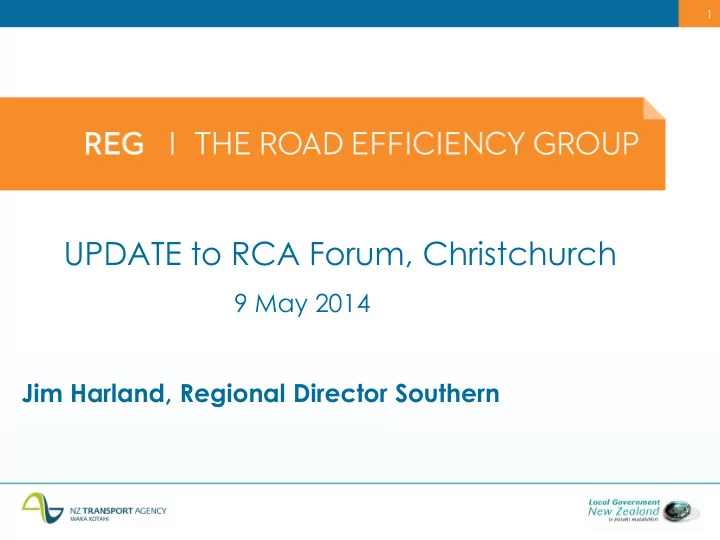

1 UPDATE to RCA Forum, Christchurch 9 May 2014 Jim Harland, Regional Director Southern
2 Strategic Context
3 REG THE ROAD EFFICIENCY GROUP THREE KEY WORKSTREAMS Strategic Context One Network Road Classification Clustering and Asset Management Collaboration Best Practice Sponsored by LGNZ and NZTA
4 One Network Road Classification (ONRC) Recognises that all roads are part of a National Network. • Categorising roads based on the functions they perform as • part of this national network. Helps local government and the Transport Agency to plan, • invest in, maintain and operate the road network. Gives road users more consistency • and certainty about what services to expect on national road network. Allows more strategic, • consistent and affordable decision making
5 Three ONRC elements Classifying roads into categories • based on their function in the national network Customer Levels of Service (CloS) define what the fit for • purpose outcomes are for each category in terms of mobility, safety, accessibility and amenity. Performance Measures - how categories and customer • levels of service translate into specific maintenance, operational and investment decisions.
6 The ONRC Classification The functional classification differentiates roads into a nationally consistent set of six categories and two sub-categories: 1. National (and high volume sub-category) 2. Regional 3. Arterial 4. Primary collector 5. Secondary collector 6. Access (with a low volume sub-category). Provisional CLoS on REG website
7
8 ONRC Progress Update Last year: Engagement with RCA and NZTA roading and planning staff, AA and Road Transport Association (RTA) reps, consultants and some mayors and councillors. Final classification and provisional CLoS endorsed by REG. Feb/Mar/Apr ‘14: First round of ONRC update presentations to LGNZ and IPWEA; workshops to develop Performance Measures. Finalisation of CLoS. May/June ‘14: Second round of update presentations to LGNZ and IPWEA; workshops to fine- tune and finalise Performance Measures; REG Governance Group to consider final outcomes in June.
9 Implementing the ONRC Self-audit on capability by questionnaire by the end of May 2014 2015 - 18 NLTP: Expectation that RCAs have applied ONRC to their network, identified differences in CLoS, agreed appropriate performance measures, understand financial implications 2018 – 21 NLTP: ONRC fully embedded in AMP decison making and subsequent RLTPs for the 2018 NLTP process
10 Information on ONRC Hand out • Website • nzta.govt.nz – type in ‘ONRC’ - “Applying the ONRC” guidelines Newsletter • 500+ subscribers stefan.wolf@nzta.govt.nz
11 Clustering and Collaboration Collaboration Continuum
12 Evolution of Collaboration
13 What is everyone else doing?
14 Collaboration Status Region Participants MOU Still in Awaiting Other Proposed discussion LG Review Northland "Twin Far North, Kaipara, Whangarei, NZTA. Yes Proposal for shared offices Coast Roading" (NZTA/WDC), plus other initiatives. Waikato Mayoral Hamilton, Otorohanga, Rotorua, Taupo, Yes Initial module collaboration under Forum Waikato, Waipa, Waitomo, Hauraki, Matamata- development, leading to future Piako, South Waikato, Thames-Coromandel, Centre of Excellence if successful. NZTA. BOP East Rotorua, Whakatane, Opotiki, Kawerau, NZTA. Renewal of NZT/RDC collaboration. BOP West Western Bay of Plenty, Tauranga, NZTA. Renewal of existing collaboration. Hawkes Bay Wairoa, Central Hawkes Bay, Hastings, Napier. Yes Gisborne Tairāwhiti Gisborne, NZTA. Implementing joint business unit and contracts. Taranaki New Plymouth, South Taranaki, Stratford. Broad project considering all Council asset classes. Manawatu Horowhenua, Manawatu, Palmerston North, Yes Wanganui Rangitikei, Tararua, Wanganui, NZTA. Wairarapa Carterton, Masterton, South Wairarapa, NZTA. Yes Greater Wellington Kapiti, Porirua, Upper Hutt, Lower Hutt, Yes Wellington. Marlborough Marlborough, Nelson, Tasman, NZTA. Yes Tasman "Top of the South" North Canterbury Hurunui, Kaikoura, Selwyn, Waimakariri, NZTA. Yes South Canterbury Ashburton, Mackenzie, Timaru, Waimate, Yes Waitaki Waitaki, NZTA. Otago/Southland Clutha, Dunedin, Gore, Invercargill, Southland. Retaining existing cooperation. Otago Central Central Otago, Queenstown Lakes, NZTA. Yes West Coast Buller, Grey, Westland, NZTA. Yes Southland Southland DC, NZTA HNO Contract model development
15 PRACTICE INTO ACTION Who are they? How do they work? What do they want to achieve?
16 Best Practice AMP Working Group
17 AMP process
18 Sharing best practice through Working with the One Network Classification Group - www.nzta.govt.nz/REG - www.nzta.govt.nz/AMP Engagement Case studies Developing a strategic plan
19 Case studies NZTA programme review (RAPT) process This case study outlines the process that the NZ Transport Agency undertakes on an annual basis to review the appropriateness of the upcoming pavement surfacing and drainage renewal programme. The review process is referred to by the Transport Agency as their RAPT review (Review and Prioritisation Team).
20 Case studies Forward works programme optimisation This case study discusses the processes that should be adopted to develop an optimised forward works programme for pavement and surfacing renewals, and the tools and methodologies that are available to achieve this. It outlines the importance of starting the prioritisation process from an optimised programme, and the efficiencies that can be achieved from an optimised programme against a worst first approach.
21 Case studies Auckland Transport Street Lighting: Energy efficiency initiatives This project identifies ways in which significant costs can be saved in street lighting across the Auckland Transport network by the adoption of advanced lighting technologies which are now technologically mature and low risk.
22 Case studies Review of RIMS Traffic Counting Guideline shifts from reactive to strategic, proactive counting • It will improve your data accuracy • It will reduce the number of counts needed • The case study identifies some challenges • Suggests some further information to help Councils • with implementation
23 Developing a strategic plan
24 Common threads Medium term: Risk • Demand • Performance management (the feedback loop) • Asset data (reliable) • Level of service • External scrutiny/share experience • Integrated • Funding/affordability • Life cycle/long term/life cycle strategies (ODM) •
25 Value for Money “ We don’t have the money, so we have to think. ” — Ernest Rutherford
Recommend
More recommend